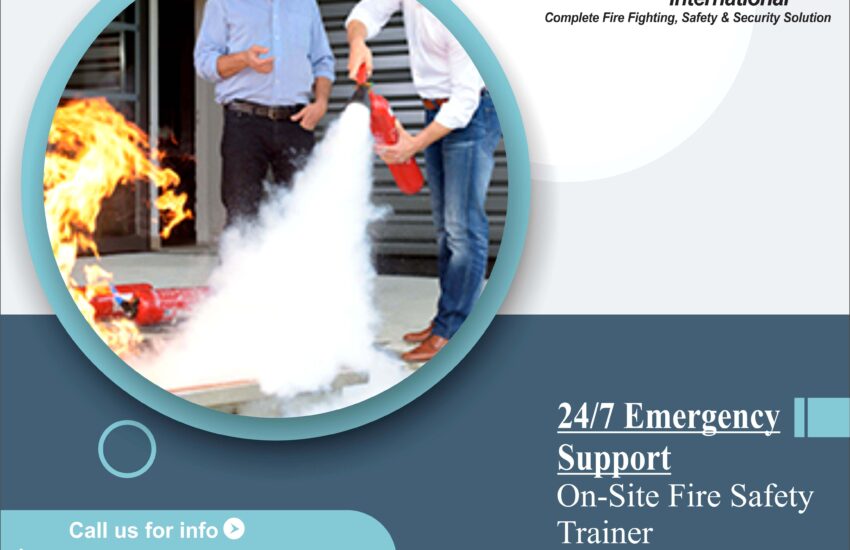On-Site Fire Safety Trainer Fire hazards present serious risks in any workplace. Whether it’s an office, warehouse, or construction site, failing to prepare for fire emergencies can lead to injury, loss of life, and significant property damage. To avoid these outcomes, many organizations choose to bring in a professional fire safety trainer directly to their site. This proactive step improves preparedness, boosts employee confidence, and ensures compliance with safety regulations.
In this article, we’ll explore the role of an on-site fire safety trainer, what to expect during training, and why investing in this service is essential for any business.
🧯 What Does an On-Site Fire Safety Trainer Do?
An on-site fire safety trainer visits your workplace to provide hands-on fire safety training. Unlike off-site seminars or online programs, this training is tailored specifically to your facility. As a result, employees learn how to respond to emergencies in their actual work environment, making the training more effective and relevant.
Additionally, trainers assess your facility for fire hazards and recommend improvements to enhance overall safety.
🏢 Benefits of On-Site Fire Safety Training
✅ Customized for Your Workplace
Since the trainer evaluates your physical environment, the training is personalized. It includes your building’s layout, fire exits, emergency protocols, and equipment. This customization makes the training more impactful than generic safety courses.
✅ Hands-On Learning
Rather than just watching videos or reading manuals, employees get to practice using fire extinguishers, identifying escape routes, and participating in evacuation drills. Consequently, they develop real-world skills that can save lives during an emergency.
✅ Helps Meet Safety Regulations
Many industries require regular fire safety training as part of legal compliance. By conducting training on-site, businesses can ensure they meet all regulatory standards without disrupting daily operations.
✅ Builds Confidence in Emergency Response
Well-trained employees respond faster and more effectively during emergencies. In addition to protecting lives, this can reduce property damage and business downtime.
🧠 What to Expect During the Training
A typical fire safety training session includes:
- A brief overview of how fires start and spread
- Identification of common fire hazards in the workplace
- Prevention strategies tailored to your operations
- Demonstrations on how to use fire extinguishers
- Practice drills for safe evacuation
- Assigning roles, such as fire wardens or team leaders
- Clear instructions on communication during an emergency
- Guidelines for post-incident actions
The session often ends with a Q&A to clarify any doubts and ensure full understanding.
🛠️ Types of Training Sessions Offered
Trainers typically offer several types of sessions based on your needs. These may include:
- Basic fire safety awareness
- Fire extinguisher operation
- Fire warden or evacuation coordinator training
- Full evacuation drills
- Industry-specific fire response workshops
- Refresher courses for existing staff
Depending on your facility, sessions can be customized for different departments or risk levels.
🧾 Legal and Safety Requirements
Government regulations require employers to provide regular fire safety training. For example, safety standards often mandate initial training during employee onboarding, as well as periodic refreshers. Local fire codes may also require documented fire drills and training for designated fire wardens.
Hiring an on-site trainer helps your business stay compliant with these rules. Furthermore, it demonstrates your commitment to employee safety.
🧑🏫 How to Choose the Right Fire Safety Trainer
Before hiring a trainer, consider the following:
- Do they hold valid fire safety certifications?
- Have they worked with businesses in your industry?
- Can they conduct both theory and practical sessions?
- Are they familiar with local safety codes and compliance requirements?
- Do they offer ongoing support or materials after the session?
Answering these questions will help you find a qualified professional who can deliver effective, engaging training.
🧭 How Often Should You Provide Training?
Regular training ensures employees stay prepared. Here’s a general guideline:
- When onboarding new employees
- Annually, as part of ongoing safety programs
- After changes to the building layout or fire equipment
- Following any fire-related incident
- When legal regulations update
Keeping training consistent reinforces safety procedures and reduces response time during an emergency.
🏭 Who Should Consider On-Site Fire Safety Training?
While every business can benefit, the following sectors often face higher fire risks:
- Manufacturing and industrial facilities
- Warehouses and distribution centers
- Healthcare institutions
- Schools and universities
- Retail stores and malls
- Hospitality and restaurants
- Construction sites
- High-rise office buildings
Each of these environments has unique safety challenges that on-site trainers can address with tailored strategies.
📋 How to Prepare for a Training Session
To make the most of your scheduled training:
- Inform all employees ahead of time
- Review your current fire safety plan
- Ensure alarms, extinguishers, and exits are accessible
- Assign fire wardens or emergency leads
- Set aside time for both classroom instruction and drills
- Collect feedback after the session for future improvements
Proper preparation ensures a smoother and more productive training experience.
🔚 Conclusion: A Smart Step Toward Safety
Fires can happen unexpectedly—but being unprepared makes the damage worse. Bringing in an on-site fire safety trainer gives your team the knowledge, confidence, and hands-on experience to act quickly and correctly during emergencies. Not only does this protect lives and property, but it also demonstrates your commitment to workplace safety and legal compliance.


